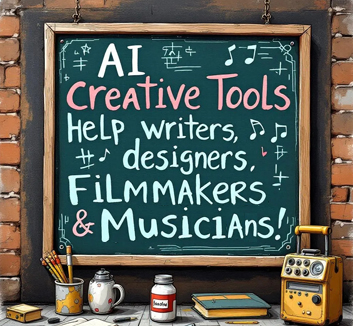AI as Creative Catalyst

How Artificial Intelligence is Transforming Artistic Expression
Artificial intelligence has quietly revolutionized the creative landscape, becoming an indispensable collaborator for writers, visual artists, filmmakers, and musicians worldwide. Rather than replacing human creativity, AI tools are amplifying artistic potential and democratizing access to sophisticated creative techniques that were once reserved for professionals with extensive training and expensive equipment.
In the realm of writing, AI has emerged as a powerful brainstorming partner and editorial assistant. Authors are using language models to overcome writer's block by generating story prompts, developing character backgrounds, and exploring alternative plot directions. Professional screenwriters employ AI to analyze dialogue patterns and suggest more natural conversational flows, while journalists leverage these tools to research topics quickly and generate first drafts that they can then refine and personalize. The technology excels at helping writers experiment with different voices and styles, allowing them to stretch beyond their comfort zones and discover new dimensions of their craft.
Visual artists have embraced AI image generation tools that can transform rough sketches into polished artwork or create entirely new pieces from text descriptions. Concept artists in the entertainment industry use these systems to rapidly prototype ideas for characters, environments, and objects, dramatically accelerating the pre-production process. Fine artists are incorporating AI-generated elements into mixed media works, creating hybrid pieces that blend human intuition with algorithmic creativity. Photography enthusiasts are using AI-powered editing tools that can intelligently enhance lighting, remove unwanted objects, and even extend the borders of their images in ways that appear seamless and natural.
The film industry has perhaps seen some of the most dramatic transformations through AI integration. Independent filmmakers can now create sophisticated visual effects that would have previously required large budgets and specialized teams. AI-driven tools can generate realistic backgrounds, remove objects from scenes, and even create digital doubles of actors for complex shots. In post-production, artificial intelligence streamlines the editing process by automatically synchronizing audio and video, suggesting optimal cut points, and even generating rough cuts based on the director's previous work patterns. Color grading, once a highly specialized skill, is becoming more accessible through AI systems that can analyze scenes and suggest aesthetic improvements while maintaining the filmmaker's intended mood and style.
Music creation has been revolutionized by AI systems that can compose melodies, generate backing tracks, and even simulate the playing styles of different instruments. Musicians are using these tools not to replace their creativity but to explore new harmonic possibilities and overcome creative blocks. Electronic music producers particularly benefit from AI-generated samples and loops that can serve as starting points for larger compositions. Even classical composers are experimenting with AI collaborations, using machine learning systems to suggest variations on themes or to explore complex orchestration possibilities that might not have occurred to them otherwise.
The democratizing effect of AI creativity tools cannot be overstated. Previously, high-quality creative work often required expensive software, specialized training, or access to professional equipment. Now, anyone with a smartphone or basic computer can access powerful creative AI tools that were unimaginable just a few years ago. This accessibility has led to an explosion of creative content from diverse voices and perspectives that might not have had the resources to participate in traditional creative industries.
However, the most significant impact of AI in creativity lies not in its ability to generate content independently, but in its capacity to enhance human imagination and remove technical barriers that previously limited artistic expression. Artists can now focus more on conceptual development and emotional resonance while AI handles routine technical tasks. This shift allows creators to iterate more rapidly, experiment with bolder ideas, and push the boundaries of their respective mediums.
The collaborative relationship between human creativity and artificial intelligence continues to evolve, with each technological advancement opening new possibilities for artistic expression. As these tools become more sophisticated and accessible, we can expect to see even more innovative uses that blur the lines between human and machine creativity, ultimately enriching the cultural landscape with new forms of art that neither humans nor AI could have created alone.
The future of creative work appears to be one of partnership rather than replacement, where artificial intelligence serves as an infinitely patient collaborator, always ready to help artists explore new territories and bring their most ambitious visions to life. This symbiotic relationship is already producing remarkable results across all creative disciplines, suggesting that we are only beginning to understand the full potential of human-AI creative collaboration.
RETURN TO HOME PAGE